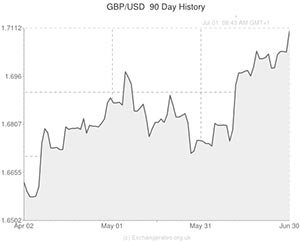
The Pound to US Dollar exchange rate (GBP/USD) dipped slightly yesterday afternoon when the latest US non-farm payrolls report hit the newswires. The hugely influential jobs figure showed that the American economy added a whopping 288,000 jobs in June, smashing forecasts of just 215,000.
The surprisingly large jump in jobs brought the headline unemployment rate down from 6.3% to 6.1% and positive signals were found all over the report, as average earnings printed at 2.0% compared to forecasts of 1.9% and the participation rate held steady at 62.8%.
The outperforming figure initially supported the ‘Greenback’ against the Pound but Sterling bears met strong resistance ahead of the 1.7100 handle and GBP/USD rallied back towards 1.7150.
This indicates that ‘Cable’s’ bullish run is likely to continue over the coming days and weeks. Federal Reserve Chairwoman Janet Yellen remains steadfast in her commitment to maintaining ultra-low interest rates, recently referring to the latest rise in CPI inflation as merely ‘noise’. With the Bank of England looking increasingly likely to start hiking rates as early as November it appears that Sterling will remain far more sensitive to positive economic indicators than the US Dollar.
1.1750 is the most important level for GBP to USD in the near-term because it marks the 50-day moving average. If Sterling can assert itself above this level through the start of next week’s session then it is likely that technical trading patterns will drive GBP/USD higher towards 1.7230.
Earlier in the day Markit Economics reported that the dominant British service sector accelerated strongly again in June. Although the 57.7 print marked a slowdown from May’s 58.6 the report did little to harm the Pound’s prospects as sub indexes for new orders and job creation remained very strong. New business hit a 7-month high and firms hired workers at the fastest pace since records began.
Taken alongside the sturdy British manufacturing and construction numbers, the report suggests that private sector growth will help GDP increase by at least 0.8% and possibly as much as 1.0% in the second quarter. The improvements in private sector employment also point towards further decreases in the headline unemployment rate, with some analysts even calling for a rate south of 6.0% by the end of the year. This all bodes well for future Sterling strength as it suggests that the Bank of England will probably be persuaded to start raising interest rates sooner rather than later.

Comments are closed.